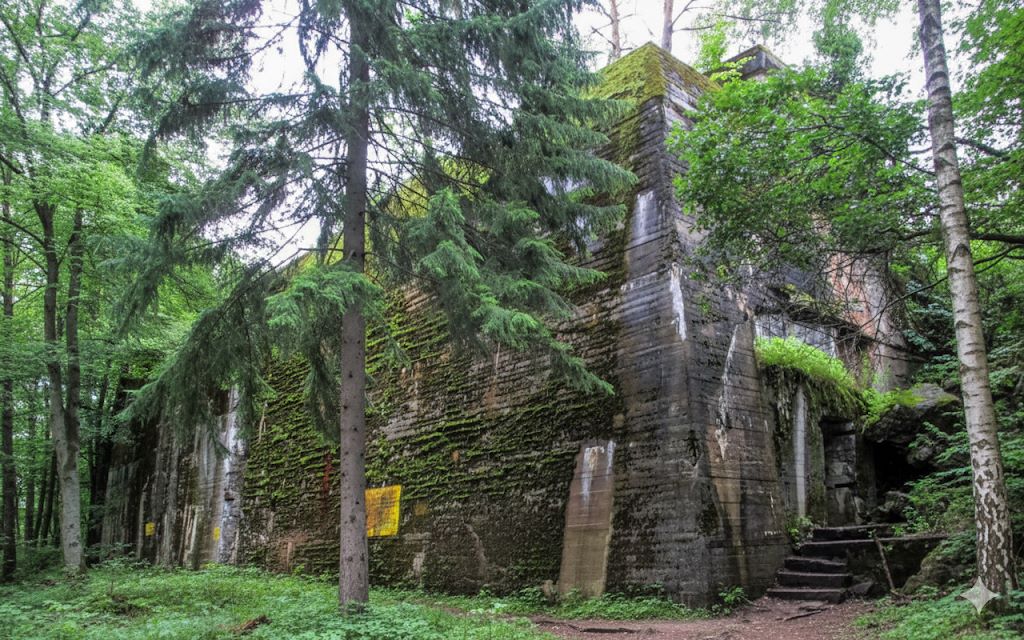A Fortress in the Forest
Deep in the Masurian woods of what was once East Prussia, hidden among towering pines and dense undergrowth, lies the crumbling remains of one of history’s most infamous military complexes. Wolf’s Lair (Wolfsschanze) was Adolf Hitler’s primary command center on the Eastern Front during World War II. Here, in a sprawling network of bunkers and barracks, the Nazi leader directed the invasion of the Soviet Union, orchestrated some of the war’s most brutal campaigns, and narrowly escaped assassination in the dramatic 20 July Plot.
Wolf’s Lair was more than just a military headquarters; it was a symbol of Nazi ambition and paranoia. Built in absolute secrecy and fortified against both enemy attack and internal betrayal, the complex became a microcosm of the Third Reich’s power and its eventual unraveling. Today, its ruins stand as a haunting reminder of the war’s devastation and the fragility of even the most heavily defended regimes.
The Birth of a Fortress: Construction and Design
Choosing the Site
The decision to build Wolf’s Lair was made in late 1940, as Nazi Germany prepared for its invasion of the Soviet Union. The location, near the small East Prussian town of Rastenburg (now Kętrzyn, Poland), was chosen for its strategic advantages: it was close enough to the Soviet border for operational efficiency but remote enough to avoid detection. The dense forest provided natural camouflage, and the surrounding lakes and marshes acted as additional barriers against ground assaults.
The site was also far from major roads and urban centers, making it difficult for enemy forces to locate or target. To maintain secrecy, locals were told that the construction was for a new cement factory. In reality, the project was overseen by Organisation Todt, the Nazi engineering group responsible for some of the regime’s most ambitious infrastructure projects.
Building the Complex
Construction began in earnest in late 1940 and was completed by June 21, 1941, just in time for the launch of Operation Barbarossa. The complex covered 6.5 square kilometers and included over 80 buildings, 50 reinforced bunkers, two airfields, and a railway station. The bunkers were constructed with steel-reinforced concrete walls up to 8 meters thick, designed to withstand even the heaviest Allied bombs.
The entire site was divided into three concentric security zones, known as Sperrkreis 1, 2, and 3. Sperrkreis 1, the innermost zone, housed Hitler’s personal bunker and those of his closest aides, including Martin Bormann, Hermann Göring, and Wilhelm Keitel. This area was ringed by steel fencing and guarded by elite SS units. Sperrkreis 2 contained barracks for SS guards, communications staff, and senior Wehrmacht officers, while Sperrkreis 3, the outermost zone, was defended by minefields, anti-aircraft batteries, and the Führerbegleitbrigade, a special armored security unit.
The complex was so well camouflaged that it was nearly invisible from the air. Artificial trees and netting were used to blend the buildings into the surrounding forest, and the entire site was designed to appear as unbroken woodland to reconnaissance aircraft.
Life Inside the Lair
At its peak, Wolf’s Lair housed between 2,000 and 3,000 people, including military personnel, staff, and even forced laborers. The site was a self-contained town, complete with its own power plant, water supply, and airstrip. Hitler’s daily routine was rigidly structured: he would begin his day with a walk around 10 a.m., followed by a military briefing, lunch, and another briefing in the late afternoon. Evenings were often spent watching films or listening to gramophone records of Beethoven and Wagner.
Despite its formidable defenses, life at Wolf’s Lair was far from comfortable. The bunkers were damp, poorly ventilated, and lacked proper bathing facilities. The atmosphere was one of constant tension, fueled by Hitler’s growing paranoia and the ever-present threat of Allied air raids.
The 20 July Plot: Assassination and Aftermath
The Conspiracy
By 1944, as the war turned decisively against Germany, a group of high-ranking Wehrmacht officers and civilians had grown disillusioned with Hitler’s leadership. They believed that removing Hitler was the only way to save Germany from total destruction. The conspirators, led by Colonel Claus von Stauffenberg, planned to assassinate Hitler and launch a coup d’état, codenamed Operation Valkyrie.
Stauffenberg, a staff officer with access to Hitler’s briefings, was chosen to carry out the assassination. On July 20, 1944, he placed a briefcase containing a bomb under the conference table in Hitler’s briefing room at Wolf’s Lair. The bomb was set to detonate during the meeting, killing Hitler and his inner circle.
The Attempt and Its Failure
The plot nearly succeeded. At 12:42 p.m., the bomb exploded, devastating the conference room. However, Hitler survived with only minor injuries. The briefcase had been moved by another officer, shielding Hitler from the full force of the blast. Four others in the room were killed, but the Führer escaped, largely unscathed.
Stauffenberg, convinced that Hitler was dead, left the complex and flew to Berlin to initiate the coup. When news reached the capital that Hitler had survived, the conspiracy collapsed. Stauffenberg and his co-conspirators were quickly arrested and executed. The failed assassination attempt marked a turning point in the war, deepening Hitler’s paranoia and accelerating the collapse of the Nazi regime.
The Aftermath
In the wake of the plot, security at Wolf’s Lair was tightened even further. Hitler, already distrustful of his generals, became increasingly isolated. The assassination attempt also exposed the growing dissent within the German military, signaling the beginning of the end for the Third Reich.
Operation Barbarossa and the Eastern Front
Launching the Invasion
Wolf’s Lair was constructed specifically to serve as the command center for Operation Barbarossa, the Nazi invasion of the Soviet Union. Hitler arrived at the complex on June 24, 1941, just two days after the invasion began. From here, he directed the massive offensive, which initially saw rapid German advances into Soviet territory.
The early months of Barbarossa appeared to be a success, with German forces encircling and capturing millions of Soviet soldiers. However, the invasion soon stalled, as the vastness of the Soviet Union, the harsh Russian winter, and the resilience of the Red Army took their toll on the Wehrmacht.
The Turning Point
By 1943, the tide of the war had turned. The Soviet victory at Stalingrad marked the beginning of a series of crushing defeats for the German army. Despite this, Hitler remained at Wolf’s Lair, refusing to acknowledge the inevitability of defeat. His insistence on holding territory at all costs led to further losses and the eventual collapse of the Eastern Front.
As the Red Army advanced toward Germany in late 1944, Wolf’s Lair lost its strategic value. Hitler departed the complex for the final time on November 20, 1944, retreating to his bunker in Berlin. The complex was partially demolished by retreating German forces in January 1945, though many of the bunkers proved too sturdy to destroy completely.
The Ruins Today: A Haunting Legacy
Abandonment and Rediscovery
After the war, Wolf’s Lair was abandoned and left to the elements. The surrounding forest gradually reclaimed the site, with moss and ferns covering the shattered concrete and twisted steel. For decades, the ruins were largely ignored, though they became a macabre attraction for curiosity seekers and, at times, a makeshift paintball site.
In 1959, the site was opened to the public, and it has since become a popular, if controversial, tourist destination. Today, Wolf’s Lair is managed by the Polish government, and visitors can explore the ruins, view historical exhibits, and learn about the events that unfolded within its walls.
Preservation and Controversy
The site’s preservation has been a subject of debate. Some argue that it should be maintained as a historical monument, a stark reminder of the horrors of war and the dangers of totalitarianism. Others fear that it could become a pilgrimage site for neo-Nazis or a place of misguided reverence.
Efforts have been made to balance preservation with education. Informational panels and guided tours provide context about the site’s history, the atrocities planned within its walls, and the broader impact of the Nazi regime. The ruins of the conference room where Stauffenberg’s bomb detonated have been preserved, serving as a poignant memorial to the failed assassination attempt and the courage of those who resisted Hitler.
Visiting Wolf’s Lair
Today, Wolf’s Lair is a place of reflection and historical inquiry. Visitors can walk among the bunkers, see the remains of Hitler’s personal quarters, and stand in the conference room where the 20 July Plot unfolded. The site is a powerful reminder of the war’s human cost and the fragility of even the most fortified regimes.
Conclusion: The Shadow of History
Wolf’s Lair stands as a testament to the ambition, paranoia, and ultimate failure of the Nazi regime. Built to be impregnable, it became a prison for its occupants, a place where the weight of war and the specter of defeat loomed large. The assassination attempt of July 20, 1944, was a desperate bid to change the course of history, and though it failed, it exposed the cracks in the Nazi facade.
Today, the ruins of Wolf’s Lair are more than just a historical site; they are a warning. They remind us of the dangers of unchecked power, the cost of war, and the importance of resistance in the face of tyranny. As the forest slowly reclaims the concrete and steel, the lessons of Wolf’s Lair endure, urging us to remember the past and to remain vigilant against the forces of hatred and oppression.
Practical Information for Visitors
- Location: Gierłoż, near Kętrzyn, Poland (about 5 miles east of the town).
- Access: The site is accessible by car, with parking available nearby. Guided tours are recommended for a deeper understanding of the history.
- Hours: Open daily, with seasonal variations. Check the official website for current hours and tour availability.
- Admission: A small fee is charged for entry, with additional costs for guided tours.
- Facilities: The site includes a museum, informational panels, and a gift shop. Visitors are advised to wear sturdy shoes, as the terrain can be uneven.
References
- Go Inside The Wolf’s Lair, Hitler’s Massive Command Center On The Eastern Front - All That’s Interesting
- Location and construction of Wolf’s Lair - Wolfsschanze.pl
- Wolf’s Lair - History Hit
- Wolf’s Lair - Military Wiki
- Hitler’s Fortified Sanctuary: Inside the Wolf’s Lair Führerhauptquartier - History Tools
- Wolf’s Lair: Hitler’s secret reinforced bunker where he planned the greatest evils of WWII - History Skills
- The Wolf’s lair - Wolfsschanze- Hitler’s Headquarters, Gierloz Poland - LandmarkScout
- Wolf’s Lair - Wolfsschanze.pl
- Wolf’s Lair: Where Hitler planned the war - DW









